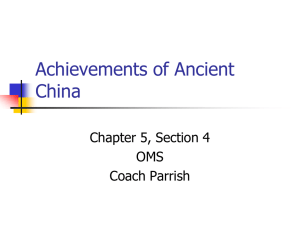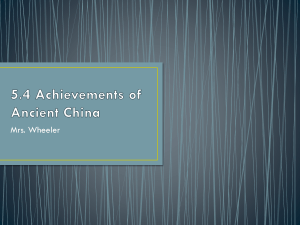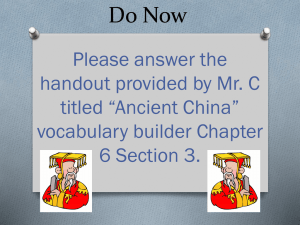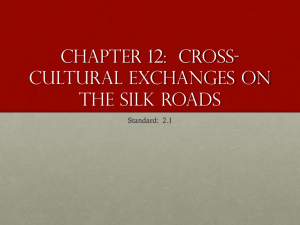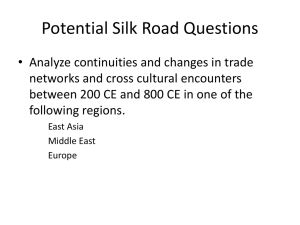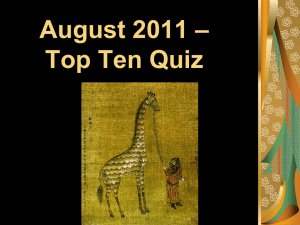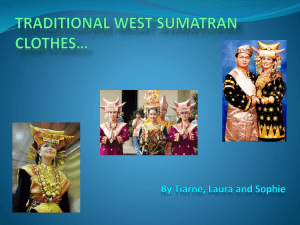Silk Road
advertisement
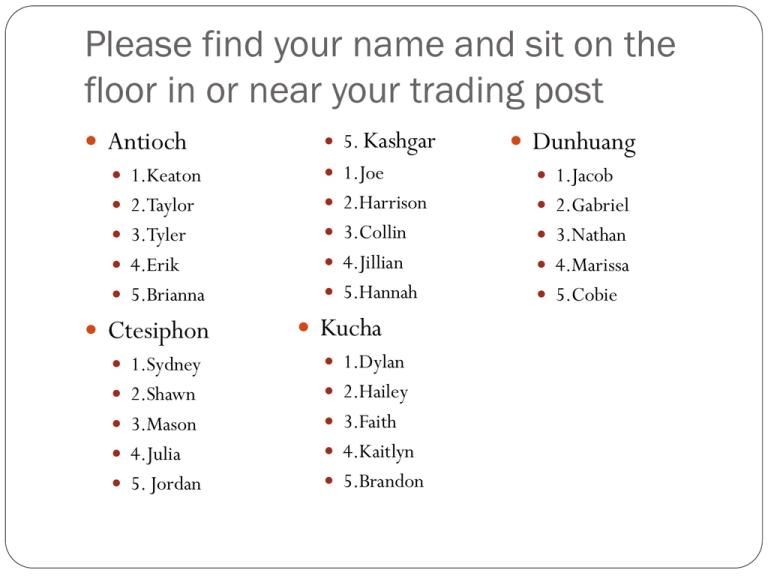
Please find your name and sit on the floor in or near your trading post Antioch 5. Kashgar Dunhuang 1.Keaton 1.Joe 1.Jacob 2.Taylor 2.Harrison 2.Gabriel 3.Tyler 3.Collin 3.Nathan 4.Erik 4.Jillian 4.Marissa 5.Brianna 5.Hannah 5.Cobie Ctesiphon Kucha 1.Sydney 1.Dylan 2.Shawn 2.Hailey 3.Mason 3.Faith 4.Julia 4.Kaitlyn 5. Jordan 5.Brandon Please find your name and sit on the floor in or near your trading post Antioch Kashgar Dunhuang 1.Nick 1.Jan 1.Harlan 2.Kyle 2.Jacob D. 2.Peyton 3.Rose 3.Kayleigh 3.Cain 4.Julian 4.Jasmyne 4.Deven 5.Garrett 5.Kenzie 5.Brad Ctesiphon Kucha 1.Drew 1.Michelle 2.Mariah 2.Eric 3.A.J. 3.Brooke 4.Azelin 4.Alyssa 5. Jacob R. 5.Emily 6. John 6. Hannah 6. Jack Please find your name and sit on the floor in or near your trading post Antioch Kashgar Dunhuang 1.Aurianna 1.Xiana 1.Haylee 2.Stephen 2.Rylee 2.Adriana 3.Brandi 3.Angelika 3.Alusha 4.Abbie 4.Danielle 4.Isaac 5.Henry 5.David 5.Elizabeth Ctesiphon Kucha 1.Ardyn 1.Autumn 2.Brooke M. 2.Saul 3.Jacob 3.Brook W. 4.Taylor 4.Kayla 5. Emily 5.Hope 6. Lorenzo Please find your name and sit on the floor in or near your trading post Antioch 5. Kashgar Dunhuang 1.Keaton 1.Joe 1.Jacob 2.Taylor 2.Harrison 2.Gabriel 3.Tyler 3.Collin 3.Nathan 4.Erik 4.Jillian 4.Marissa 5.Brianna 5.Hannah 5.Cobie Ctesiphon Kucha 1.Sydney 1.Dylan 2.Shawn 2.Hailey 3.Mason 3.Faith 4.Julia 4.Kaitlyn 5. Jordan 5.Brandon Bellringer Describe what you see on the map? Predict what the red line indicates Objectives Students will be able to… Cite the locations of the trans-Eurasian “silk roads” in the period of the Han dynasty and the Roman Empire Describe the difficulties of travel along the Silk Road Cite the significance of the trans-Euransian “silk roads” in the period of the Han dynasty Describe the diffusion of Buddhism northward to China during the Han dynasty Questions to Consider What do you think happened along the Silk Road? Why do you think it was called the Silk Road? Which cities can you find along the Silk Road? How many miles do you think the Silk Road stretched? What parts of the Silk Road do you think would be most dangerous to travel? Why? The Silk Road In the last section you learned about the achievements of the Han dynasty. Under the Han, trade routes were opened that allowed the Chinese to trade with other ancient cultures. You are about to explore the great trade route known as the Silk Road. The Silk Road was actually a network of smaller trade routes that stretched more that 4,000 miles across Asia. It reached from Luoyang and the Han capital of Chang’an in china to Mediterranean ports such as Antioch in Syria. By the fist century A.D. the Mediterranean region was dominated by the Roman Empire, whose capital city was Rome (in present day Italy). The Silk Road connected the great empires of the Han and the Romans. Both goods and ideas traveled along the Silk Road. The Chinese traded spices from India and glassware from Rome. New ideas, including Buddhism, also entered China as a result of this trade. The Silk Road linked the peoples of the East and the West for more than 1,000 years. You will learn about the opening of the Silk Road. You’ll discover what traveling the Silk road was like in the time of the Han. You’ll also learn about the goods and ideas that were exchanged between the cultures of Asia and the West. 4 1 Danger! Animals and Insects! Antioch Animals Masking Tape Danger! Mountains! 2 Ctesiphon 3 Kashgar Kucha Butcher Paper Masking Tape Desks Masking Tape Danger! Sandstorm! Rules of the Game String Masking Tape 5 Danger! Bandits! Dunhuang 1. Assign each person in your group a number, starting from 1.You may move only when your number is called. 2. You may move to only one “trading center,” indicated by a group of four desks, at a time. You may move in either direction, but you must move only to trading centers that are connected by tape. 3. You must cross certain obstacles when moving from one trading center to another. 1. Dunhuang and Kucha you must crab walk ( to avoid bandits) 2. Kucha and Kashgar you must close your eyes when going over the butcher paper (desert) 3. Kashgar and Ctesiphon you must climb carefully over the desks (mountains) 4. Ctesiphon and Antioch you must hop over the pictures (lion and scorpion) 4. If you fail to follow any of these rules, you much return to the trading center that you started at and miss your turn to trade. 5. When you arrive at the new trading center, you may trade one of your products for a product someone else has. Only a new arrival can suggest a possible trade. 6. When you have five different products, wait your turn and then begin your trip back to your home trading center. On your return trip, you do not have to trade. When you arrive where you began, raise your hand. I will check your products and give you the next directions. Debriefing Activity Go back to the “trading post” where you started and sit down. I will ask one question at a time, give your group a chance to discuss and then call a number to have someone share. You will use the same number for this activity that you used in the Silk Road activity Cont. Debriefing Activity What did you like about the activity? What didn’t you like? What were some of the products that were traded on the Silk Road and where did they come from? What did a trader need to begin an expedition? What were some of the difficulties of traveling the Silk Road? Which groups had to travel the farthest to get the products they wanted? What do you think happened to the price of those products when traders returned home to sell them? How many of you traveled from one end of the Silk Road to the other? Why do you think traders did not travel the entire route? Why might someone say trade along the Silk Road resembled a chain? How might trading contribute to the rich cultural exchange along the Silk Road? Exit Ticket On a sheet of notebook paper answer the following questions: What were the cities along the silk road? Describe the difficulties of travel along the Silk Road. Explain the importance of the silk road in the period of the Han dynasty Describe how Buddhism spread northward to China during the Han dynasty J- Justify your A- answers by G- giving details that S- support the answer

